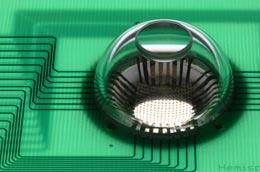Flexible circuits should lead to diverse imaging applications.
An eye-shaped camera made from a flexible mesh of silicon light-detectors marks a significant step towards creating a 'bionic' eye, its inventors say.
 A single lens, mounted on top of a transparent cap, focuses light onto the flexible electronic circuit beneath.John Rogers/Nature
A single lens, mounted on top of a transparent cap, focuses light onto the flexible electronic circuit beneath.John Rogers/NatureConventional cameras use a curved lens to focus an image onto a flat surface where the light is captured either by film or by digital sensors. However, focusing light from a curved lens onto a flat surface distorts the image, necessitating a series of other lenses that reduce the distortion but tend to increase the bulk and cost of a device.
By contrast, human eyes require only a single lens and avoid much of this distortion, because the image is focused onto the curved surface at the back of the eyeball. John Rogers, a materials scientist at the University of Illinois at Urbana-Champaign, and his colleagues have taken inspiration from our own eyes to create an electronic version1.
It's a problem that many researchers have worked on over the last few decades. The key hurdle has been the rigidity of established electronic materials, which fracture when bent.
Flexible scaffold
The team's solution was to use a series of silicon photodetectors (pixels) connected by thin metal wires. This network is supported and encapsulated by a thin film of polyimide plastic, allowing the flexible scaffold to bend when compressed. This scaffold takes up the mechanical stress and protects the pixels as the array takes its hemispherical shape.
The team made a hollow dome about 2 centimetres wide from a rubber-like material called poly(dimethylsiloxane). They flattened out the stretchy dome, and attached the electronic mesh. Then, as the hollow dome snapped back into its original shape, it pulled the array with it, forming a hemisphere that could be attached to a lens; the basis of the camera
“The ability to wrap high quality silicon devices onto complex surfaces and biological tissues adds very interesting and powerful capabilities to electronic and optoelectronic device design,” says Rogers. "It allows us to put electronics in places where we couldn't before."
The research was described as a “breakthrough” by Dago de Leeuw, a research fellow with Philips Research Laboratories based in Eindhoven, the Netherlands. The technique could work for any application where you would want to have stretchable electronics, and is limited only by what sensors you can add to the array.
Higher resolution
To improve the camera’s resolution, the researchers have also experimented with another of nature's designs. The constant motion of the human eye means that we get many views of an object, which we automatically combine to give us a better picture of what we’re looking at, explains Rogers. So his team has done the same, taking several images with their camera at slightly different angles and then combining them with computer software to give a much sharper image.
Takao Someya of the University of Tokyo, Japan, who also works on stretchable electronics, says that the camera marks a great advance in the field of stretchable electronics, with potential applications including bionic implants, robotic sensory skins and biomedical monitoring devices2.
At the moment, the camera is limited to 256 pixels, but this could be easily scaled up, says Rogers. Advantageously, this electronic eye camera exploits technology that already exists, so facilities currently fabricating planar silicon devices should be able to adapt to making this new technology.



No comments:
Post a Comment